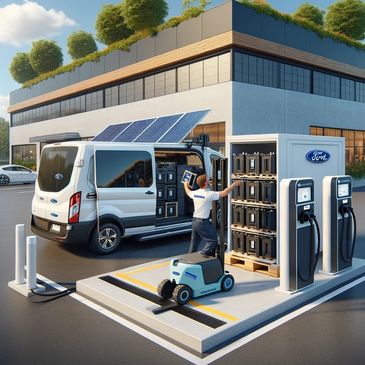BESS is Building an Off Grid Future



BESS Supplies a Variety of Energy Management Solutions
Renewable energy sources have gained in popularity and solar energy has emerged as a viable and sustainable option for powering our homes and businesses. To maximize the benefits of solar energy, energy storage systems are essential, allowing excess energy to be stored for later use when the sun is not shining. Among various energy storage options, batteries play a crucial role in storing and delivering clean energy during peak demand and power outages. BESS currently provides solar powered mobile solutions for property maintenance contractors in 12 and 24 kwh configurations powered by either Lithium-Ion or Lead-Acid. Custom modules are available. Below we will explain the different types of batteries used for energy backup storage with solar systems.
Lithium-Ion
Gel Lead-Acid
Lithium-Ion

Lithium-ion batteries have revolutionized the world of energy storage due to their high energy density, efficiency, and longer lifespan compared to lead-acid batteries. They can handle deeper discharges, making them more suitable for daily cycling in solar systems. Lithium-ion batteries also offer a compact and lightweight design, making installation and maintenance easier. While they have a higher upfront cost, their performance, efficiency, and longer life justify the investment.
Lead-Acid
Gel Lead-Acid
Lithium-Ion

Lead-acid batteries are one of the oldest and most widely used types of batteries for solar energy storage. They come in two variations: flooded lead-acid and valve-regulated lead-acid (VRLA) batteries. Flooded lead-acid batteries contain a liquid electrolyte, while VRLA batteries are sealed and maintenance-free. These batteries are relatively affordable, making them accessible for small-scale solar systems. However, they have limited depth of discharge (DoD) and shorter lifespans compared to other options.
Gel Lead-Acid
Gel Lead-Acid
Gel Lead-Acid

A gel battery, also known as a gel cell battery or gel electrolyte battery, is a type of lead-acid battery that uses a gel-like substance as the electrolyte. The gel electrolyte is created by adding a silica-based gel to the sulfuric acid, which thickens the electrolyte and immobilizes it within the battery's cells. This gel-like consistency prevents the risk of acid spillage and leakage, making gel batteries maintenance-free and safer to handle.
Sodium-Ion
Nickel-Cadmium
Gel Lead-Acid

Sodium-ion batteries are an emerging alternative to lithium-ion batteries, particularly for grid-scale energy storage. They use sodium ions instead of lithium ions, which are more abundant and, therefore, potentially more cost-effective in the long run. Sodium-ion batteries are considered safer than lithium-ion batteries as they are less prone to overheating and have a lower risk of fire. However, they are still in the early stages of commercialization and may not be as readily available as lithium-ion batteries.
Flow
Nickel-Cadmium
Nickel-Cadmium

Flow batteries are unique in their design and offer significant advantages for large-scale solar energy storage. They use two tanks of liquid electrolyte that flow through a membrane stack, generating electricity. Flow batteries can be recharged by replacing the electrolyte, allowing for virtually unlimited energy storage capacity. They have a long lifespan and can be cycled without significant degradation. While flow batteries are expensive to manufacture, they excel in applications that require extended discharge times and large storage capacity.
Nickel-Cadmium
Nickel-Cadmium
Nickel-Cadmium

Nickel-cadmium (Ni-Cd) batteries were widely used in the past but have been gradually replaced by more advanced technologies. They are durable, with a long cycle life and high discharge and charge efficiency. However, Ni-Cd batteries are toxic due to the presence of cadmium, making them less environmentally friendly. As a result, they are rarely used in modern solar energy systems.
Choosing the right battery for energy backup storage in solar systems depends on factors like cost, capacity, efficiency, and intended application. At Bess Rentals, we utilize both lead-acid and lithium-ion batteries. Lead-acid batteries are cost-effective but have limitations for long term performance, while lithium-ion batteries offer higher efficiency and longevity. Sodium-ion batteries and flow batteries are promising technologies with potential benefits for large-scale energy storage. As the renewable energy sector continues to evolve, advancements in battery technology will further enhance the efficiency and sustainability of solar energy systems, driving us towards a greener and more sustainable future.

BESS Rentals, a RMS Restructuring LLC Company
Elm City, NC | Williamsburg, VA
Copyright © BESS Rental - All Rights Reserved.
